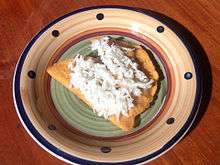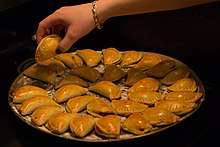Empanada
 Two empanadas | |
| Course | Appetizer |
|---|---|
| Serving temperature | Hot or cold |
| Main ingredients | Pasty, filling |
| Variations | Pastel, Pasty |
An empanada (Spanish pronunciation: [empaˈnaða]) is a type of pasty baked or fried in many countries of the Americas and in Spain. The name comes from the Spanish verb empanar, meaning to wrap or coat in bread.
Empanadas are made by folding dough over a stuffing, which may consist of meat, cheese, corn, or other ingredients.
Origins
Empanadas trace back their origins to the northwest region of Spain, Galicia.[1][2][3] A cookbook published in Catalan in 1520, Libre del Coch by Robert de Nola, mentions empanadas filled with seafood in the recipes for Catalan, Italian, French, and Arabian food.[4][5]
By country and region
Argentina
Argentine empanadas are often served during parties and festivals as a starter or main course. Shops specialize in freshly made empanadas, with many flavors and fillings.
The dough is made with wheat flour and beef drippings for the fillings which differs from province to province. Some places use chicken, and some places beef (cubed or ground depending on the region) spiced with cumin and paprika. Some other fillings are onion, boiled egg, olives, or raisins. Empanadas can be baked or fried. It also can contain ham, fish, humita (sweetcorn with white sauce), or spinach; a fruit filling is used to create a dessert empanada. For the interior regions, they can be spiced with peppers.
In those places (usually take-out shops) where several types are served, a repulgue, or pattern, is added to the pastry fold to distinguish the varieties (although it is more common nowadays to burn a letter – an abbreviated indication of the filling – into the dough). In larger cities, empanadas are eaten more as take-away food, sourced from restaurants specializing in this dish. They usually carry dozens of different varieties, which is not the case in northern provinces, where empanadas are usually made at home, with more traditional recipes.
During Lent and Easter, empanadas de Cuaresma fillings with fish (usually dogfish or tuna) are popular.[6]
Belize

In Belize, empanadas are known as panades. They are made with masa (corn dough) and typically stuffed with fish, chicken, or beans.[7] They are usually deep fried and served with a cabbage or salsa topping. Panades are frequently sold as street food.[8]
Cape Verde
Cape Verde cuisine features the pastel, as well. Cape Verdean pastéis are often filled with spicy tuna fish. One particular variety, the pastel com o diabo dentro (literally: Pastel with the devil within), is particularly spicy, and is made with a dough made from sweet potatoes and cornmeal.[9]
Chile

The empanada is considered the most symbolic food of the country.[10] Salvador Allende, the President of Chile from 1970 to 1973, emphasized the national character of his political project saying that it would be a "revolution with the flavor of red wine, and the scent of an empanada".[11]
Eating empanadas, especially the meat ones called "empanadas de pino", becomes more popular during September, the month that Chile celebrates las fiestas patrias or their independence.[12] They are eaten during meals like asados or Chilean barbeques, and are accompanied with drinks like la chicha and red wine.[13]
Meat empanadas ("de pino") are filled with ground beef, fried with white onion and are seasoned with garlic, hard-boiled eggs, olives, and sometimes raisins.[14] This version is known as the typical baked Chilean empanada, although it can also be fried.
Seafood empanadas are filled with crab, clams, sea snails, or special oysters called crassostrea and cheese. Different seafood can be used, and they are mixed with chopped white onion.[15]
Philippines
.jpg)
Filipino empanadas usually contain ground beef, pork or chicken, potatoes, chopped onions, and raisins (somewhat similar to the Cuban picadillo) in a somewhat sweet, wheat flour bread. There are two kinds available: the baked sort and the flaky fried type. To lower costs, potatoes are often added as an extender, while another filling is kutsay, or garlic chives (kutsay in Cebuano and Tagalog; 韭菜 kú-chhài in Lan-nang).
Empanadas in the northern part of the Ilocos are different. These usually have savoury fillings of green papaya, mung beans, and sometimes chopped Ilocano sausage (chorizo) and egg yolk.[16]
Sicily (Italy)
The 'Mpanatigghi are stuffed, consisting of halfmoon-shaped panzarotti filled with a mixture of almonds, walnuts, chocolate, sugar, cinnamon, cloves and minced beef.[17][18][19] These are typical of Modica, in the province of Ragusa, Sicily. They are also known as impanatiglie or dolce di carne (pasty of meat).[20]
They were probably introduced by the Spaniards during their rule in Sicily which took place in the sixteenth century; this is suggested from the etymology of the name which comes from the Spanish "empanadas or empadillas" (empanada), as well as from the somewhat unusual combination of meat and chocolate, which occurs several times in the Spanish cuisine.[17][18][21] In past centuries for the preparation of 'mpanatigghi game meat was used but today beef is used.[17]

United States
Empanadas, mainly based on South American recipes, are widely available in New York City from food carts, food trucks, and restaurants.[22] Empanadas are usually found in U.S. areas with a large Hispanic population, like Miami, San Antonio, [23][24] and Los Angeles.[25]
See also

- List of stuffed dishes
- Turnover (food)
- Çiğ börek
References
- ↑ "Historia de la empanada criolla" (PDF). Dra. Susana Barberis. Retrieved 8 July 2010.
- ↑ Penelope Casas (1982), The Food, Wines, and Cheeses of Spain, Alfred A. Knopf, New York 1982 (p. 52)
- ↑ "Breve historia de la alimentación en Argentina". Liliana Agrasar. Retrieved 8 July 2010. They first appeared in medieval Iberia during the time of the Moorish invasions.
- ↑ Adamson, Melitta Weiss (2004). Food in medieval times. Greenwood Publishing Group. ISBN 0-313-32147-7.
- ↑ Lady Brighid ni Chiarain. "An English translation of Ruperto de Nola's Libre del Coch". Stefan's Florilegium. Retrieved January 31, 2011.
- ↑ "Argentine Atún Empanadas". Retrieved 26 January 2015.
- ↑ "Belizean Food". Belize.com. ITM Ltd. Archived from the original on 2015-12-02. Retrieved 1 December 2015.
- ↑ Kraig, Bruce; Sen, Colleen Taylor, eds. (2013). Street Food Around the World: An Encyclopedia of Food and Culture. Santa Barbara, California: ABC-CLIO. p. 72. ISBN 978-1-59884-954-7.
- ↑ Hamilton, Cherie. Cuisines of Portuguese Encounters, Hippocrene Books. 2001.
- ↑ Eyzaguirre Lyon (1986), p. 24
- ↑ Gonzalo Martner Fanta, p. 23
- ↑ "La ruta de las empanadas", La Segunda. 11 September 2012.
- ↑ The Chilean empanada, This is Chile, November 3, 2009
- ↑ Pereira Salas (1977), p. 60
- ↑ Chile Travel Pulse, March 3, 2017
- ↑ Ian Ocampo Flora (April 23, 2010). "Vigan Empanada and the gastronomic treats of Ilocos". www.sunstar.com.ph. Archived from the original on 5 May 2010. Retrieved 30 December 2010.
- 1 2 3 Red. Spe. (31 July 2013). "Quanto è "dolce" Ragusa". Corriere del Mezzogiorno.
- 1 2 Giovanni Assenza (2014). Miele, garofano, cannella. I profumi dei dolci di Sicilia. Assenza. ISBN 605-030-594-3.
- ↑ Nicky Pellegrino (2013). The Food of Love Cookery School. Hachette UK. ISBN 1-4091-3381-8.
- ↑ Monica Cesari Sartoni (2005). Mangia italiano. Guida alle specialità regionali italiane. Morellini Editore. ISBN 88-89550-05-8.
- ↑ Touring Club of Italy (2005). Authentic Sicily. Touring Editore. ISBN 88-365-3403-1.
- ↑ "10 Spots To Score Excellent Empanadas In NYC" Archived 2016-07-08 at the Wayback Machine. by Angely Mercado, Gothamist, 13 October 2014;
"NYC Food Truck Lunch: Empanadas From La Sonrisa Empanadas" by Perry R., CBS New York, 9 October 2015 - ↑ "The 15 Best Places for Empanadas in San Antonio". FourSquare. Retrieved January 4, 2017.
- ↑ Rice, Janae. "Finding Empanadas in SA". San Antonio Current. Retrieved January 4, 2017.
- ↑ Chabala, Tracy. "5 Great Baked Empanadas in Los Angeles". LA Weekly. Retrieved January 4, 2017.
External links

- How to Make Empanadas—Step-by-step guide with pictures on how to make empanadas.
